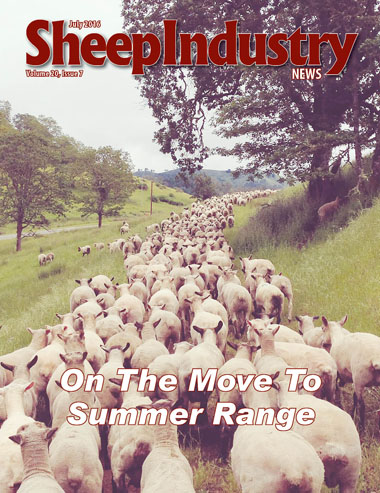
- July 2016
- President’s Notes
- Yellowstone Menus Offer Lamb
- ASI Comments on Behalf of USSES
- ASI Photo Contest
- Industry Recommends Research Priorities
- Sheep Center Sets Grant Deadline
- Sale Strengthens Lempriere
- Appropriations Update from Washington, D.C.
- Guaranteed for Life
- Young Entrepreneur: Sarah Spear
- CSU Vet Team Works Wyoming Ranch
- NSIP Offers Producers Online Tools
- Obituary
- Market Report
- Around the States
- The Last Word
To View the July 2016 Digital Issue — Click Here

Budgets Developed for National Programs
Burton Pfliger, ASI President
July tends to be the start of meetings in sheep country with several state associations from Colorado to Texas holding their annual conventions. April through June tend to be too busy for most producers to participate, due to spring livestock and field work. By July, stock is on summer grazing and the work will begin again at shipping time.
The ASI Wool Council meets in July in Denver primarily to recommend a wool program budget for the next fiscal year, which begins on Oct. 1. I will bring ASI’s executive board together at the end of July to consider the wool budget plus the unrestricted budget, which includes dues and fundraising for the legislative and association business funding. We will also discuss membership rates, and this and both budgets will go to the full ASI board in August for a vote. We were able to do the board vote electronically last year, which saved time and travel for the 60-plus directors. We anticipate another electronic budget vote in 2016.
The national conventions of the two major political parties will be held in July, as well, which must mean the politically active leaders have their spring work done also.
The new logo of the American Wool Council has been receiving positive feedback, so I compliment everyone involved for the effort to update the look of program. I believe the international wool delegations will have completed their travels in the U.S. by the time you read this. We have experienced agents in China, India, Denver and across the U.S., working with domestic wool buyers, processors and the military to market American wool.
I anticipate we will budget a supplemental program again this year to fund the Let’s Grow program, which generates excitement in the sheep industry.
Also, I am pleased to say all 46 state associations are current on their dues. Remember that all dues gathered at the national level are spent in Washington, D.C., in an effort to support the U.S. sheep industry. In fact, our budget requires ASI staff to generate an amount larger than the dues to cover a share of costs of the national office and magazine, weekly newsletter and member programs.
As a volunteer organization, sheep producers’ contributions are key. Both the checks written and time spent on councils/committees and boards play a valuable role in securing the future of this association. More than 200 sheep producers and feeders participate every year to make the operation run.
I can report on hearings that the agriculture committees of the U.S. House and Senate held regarding livestock, dairy and poultry industries. The topics that received attention were the volatility in cattle prices and questions of their futures market.
The Clean Water Act and the Endangered Species Act were problematic for all producers, and the current strong U.S. dollar is hampering exports. ASI asked the committees to support our lamb price reporting changes and resolution of the absent formula lamb sales, which are both in the hands of the U.S. Department of Agriculture this month. Poultry producers mentioned issues with the proposed organic rule of USDA, however, from the sheep perspective we didn’t find any bad precedents in the rule.
Another hot topic is the announcement by USDA Secretary Tom Vilsack that the department will publish updated regulations for the Grain Inspection, Packer and Stockyards Act. USDA plans to revisit the 2010 proposal regarding livestock and poultry sales. Judging by the discussion of several senators and representatives on the committees and the cattle and poultry organizations in particular, the rule is as controversial to their industries as it was half a dozen years ago.
Lastly, I would encourage producers to join with us in celebrating the 100th anniversary of the U.S. Sheep Experiment Station next month in Idaho. Details for the three-day celebration are available at Sheepusa.org.
I hope the rest of your summer is productive and weather cooperative for you.

